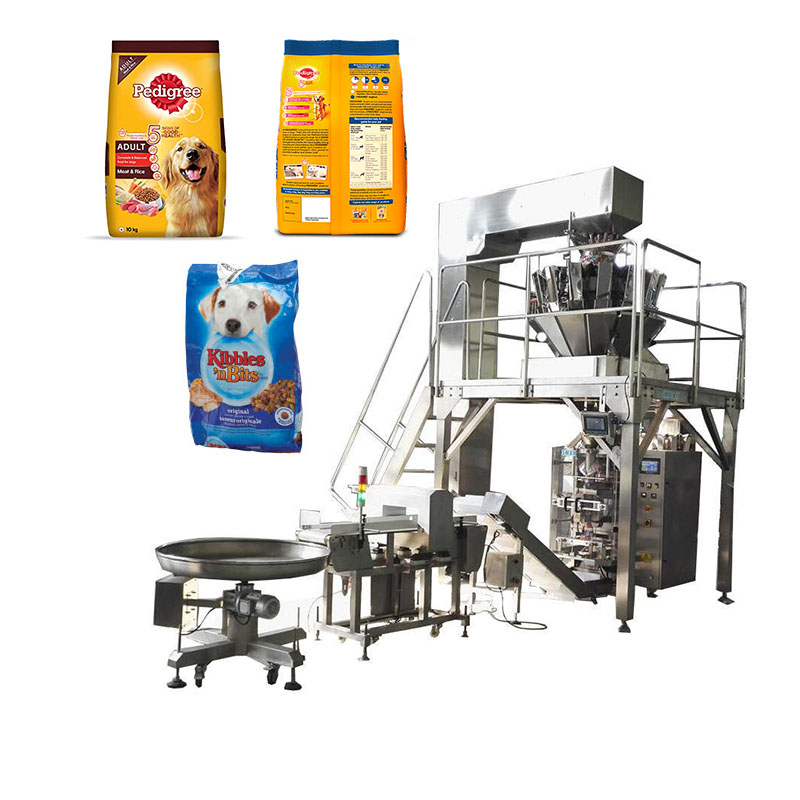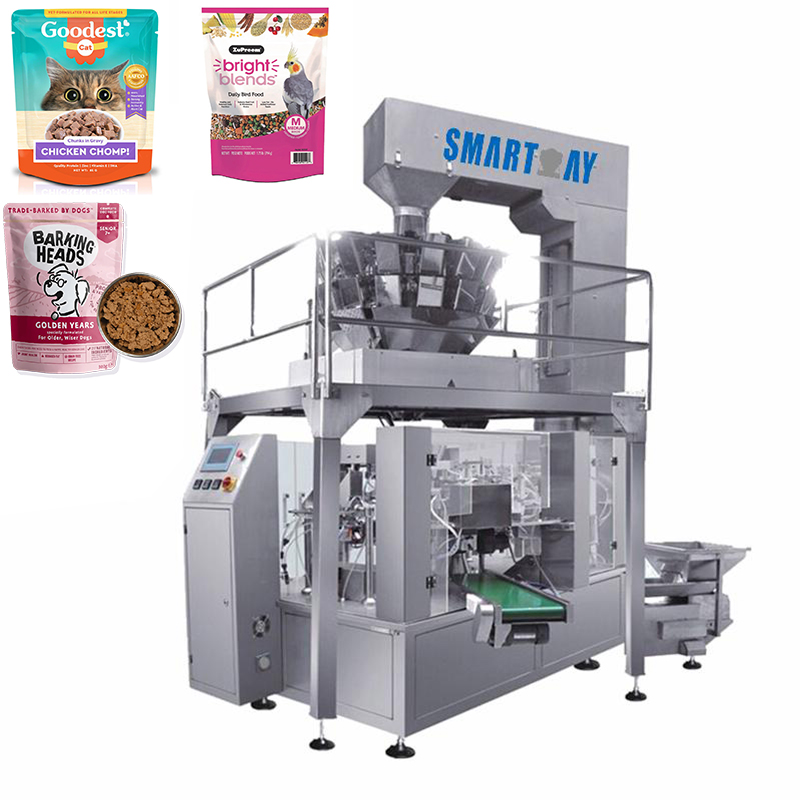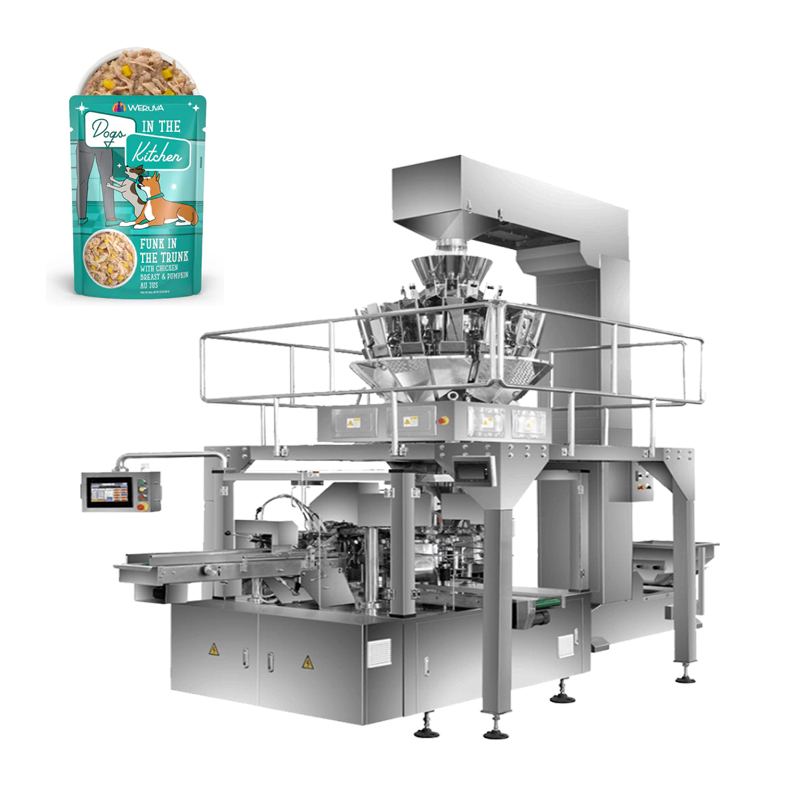Since 2012 - Smart Weigh is committed to helping clients increase productivity at a reduced cost. Contact us Now!
Since 2012 - Smart Weigh is committed to helping clients increase productivity at a reduced cost. Contact us Now!

The pet food market is still growing, and it is becoming more and more diverse. This means that there are now several groups of pet food that need their own unique packaging solutions. Today's market needs packaging solutions that can handle kibble, treats, and wet food in ways that are specific to each type of food. These three types of food are very different from each other and need to be handled in distinct ways. Pet owners are demanding better packaging that keeps food fresh and shows off the quality of the product. Manufacturers need to come up with specific solutions for each product format.
Recent studies in the industry show that 72% of pet food makers now make more than one type of food. This can make things harder to run when the wrong equipment is used for several types of food. Instead of trying to use one machine for all types of pet food, companies are now making format-specific equipment that works best for each type of pet food.
Pet food makers have found that specialised packaging methods for each product format work better than general-purpose packaging systems in terms of manufacturing efficiency, package quality, and less harm to the product. Manufacturers may get the best performance out of each sort of product by investing in equipment that is tailored to that format instead of using general-purpose machinery.
Understanding the different packaging needs for kibble, snacks, and wet food items has become important for manufacturers that want to develop their businesses and make their production more efficient. Each specialised system has technological elements that are made to work with the unique qualities of these distinct types of pet food. This leads to higher throughput, better package integrity, and better shelf appeal.
The industry has developed three distinct packaging technology platforms optimized for each major pet food category:
Kibble packaging systems featuring multihead weighers paired with vertical form-fill-seal machines that excel at handling free-flowing dry products with high accuracy and speed.
Treat packaging solutions utilizing specialized multihead weighers with pouch packing machines specifically designed for irregularly shaped products, particularly challenging stick-type treats.
Wet pet food packaging equipment incorporating customized multihead weighers with vacuum pouch systems that maintain product integrity while ensuring leak-proof seals for high-moisture products.

Dry kibble presents distinct packaging requirements due to its physical properties. The granular, free-flowing nature of kibble makes it ideal for gravity-fed systems, but creates challenges in achieving precise weight control due to variations in piece size, density, and flow characteristics.
System Components and Configuration
The standard kibble packaging system combines a multihead weigher with a vertical form-fill-seal (VFFS) machine in an integrated configuration. The multihead weigher, typically mounted directly above the VFFS unit, consists of 10-24 weighing heads arranged in a circular pattern. Each head independently weighs a small portion of kibble, with a computer system combining optimal combinations to achieve target package weights with minimal giveaway.
The VFFS component forms a continuous tube from flat film, creating a longitudinal seal before product is discharged from the weigher through a timing hopper. The machine then forms transverse seals, separating individual packages that are cut and discharged to downstream processes.
Advanced kibble weighing packing systems include:
1. Infeed conveyor: distribute product to weighing heads
2. Multihead weigher: precision weigh and fill kibble into package
3. Vertical form fill seal machine: form and seal the pillow and gusset bags from the roll film
4. Output conveyor: conveyor the finished bags to next process
5. Metal detector and checkweigher: check if there is metal inside the finished bags and double confirm the packages weight
6. Delta robot, cartoning machine, palletizing machine (optional): make the end of line in automatic process.
Technical Specifications
Kibble packaging systems deliver industry-leading speed and accuracy:
Packaging speeds: 50-120 bags per minute depending on bag size
Weight accuracy: Standard deviation typically ±0.5 grams for 1kg packages
Package sizes: Flexible range from 200g to 10kg
Packaging formats: Pillow bags, quad-seal bags, gusseted bags, and doy-style pouches
Film width capacity: 200mm to 820mm depending on bag requirements
Sealing methods: Heat sealing with temperature ranges of 80-200°C
The integration of servo motors throughout modern systems enables precise control over bag length, sealing pressure, and jaw motion, resulting in consistent package quality even at high speeds.
Advantages for Kibble Packaging Applications
Multihead weigher/VFFS combinations offer specific advantages for kibble products:
1. Minimal product breakage due to controlled product flow paths with optimized drop distances
2. Excellent weight control that typically reduces product giveaway by 1-2% compared to volumetric systems
3. Consistent fill levels that improve package appearance and stacking stability
4. High-speed operation that maximizes production efficiency
5. Flexible changeover capabilities for different kibble sizes and package formats
5. Modern systems feature user-friendly interfaces with pre-programmed recipes for different products, enabling format changes in 15-30 minutes without specialized tools.

Because pet treats come in so many different shapes and sizes, especially stick-type treats that don't respond well to traditional handling methods, packaging them can be difficult. Treats come in a wide range of shapes, sizes, and levels of fragility. For example, dental sticks and jerky are very different from biscuits and chews. This irregularity requires sophisticated handling methods that can orient and arrange products without breaking them.
Many high-end treats need to be visible through their packaging to show off the quality of the product, which means that the products need to be placed exactly right in relation to the viewing windows. The focus on how treats are presented in marketing means that packaging needs to keep the products in line and stop them from moving around during shipping.
Treats often have more fat and flavour enhancers that can go onto the packing surfaces, which could weaken the seal. Because of this, unique grasping and sealing methods are needed to keep the quality of the package even when there is product residue.
System Components and Configuration
Treat packaging systems feature specialized multihead weighers designed explicitly for stick-type treats, ensuring vertical filling into pouches.
1. Infeed conveyor: distribute product to weighing heads
2. Customize Multihead weigher for stick products: precision weigh and vertically fill treats into package
3. Pouch packing machine: fill the treats into premade pouches, seal them vertically.
4. Metal detector and checkweigher: check if there is metal inside the finished bags and double confirm the packages weight
5. Delta robot, cartoning machine, palletizing machine (optional): make the end of line in automatic process.
Specification
| Weight | 10-2000 grams |
| Speed | 10-50 packs/min |
| Pouch Style | Premade pouches, doypack, zipper bag, stand up pouches, side gusset pouches |
| Pouch Size | Length 150-4=350mm, width 100-250mm |
| Material | Laminted film or single layer film |
| Control Panel | 7" or 10" touch screen |
| Voltage | 220V, 50/60Hz, single phase 380V, 50/60HZ, 3 phase |

Wet pet food is the hardest to package since it has a lot of moisture (usually 75–85%) and can get contaminated. Because these products are semi-liquid, they need special handling equipment that keeps spills from happening and keeps seal areas clean even when there is product residue.
Wet items are very sensitive to oxygen, and exposure can cut their shelf life from months to days. Packaging needs to create almost total barriers to oxygen while also allowing for the filling of thick foodstuffs that may have chunks, gravy, or gels in them.
System Components and Configuration
1. Infeed conveyor: distribute product to weighing heads
2. Customize Multihead weigher: for wet pet food such as tuna, precision weigh and fill into package
3. Pouch packing machine: fill, vacuum and seal the premade pouches.
4. Checkweigher: double confirm the packages weight
Specification
| Weight | 10-1000 grams |
| Accuracy | ±2 grams |
| Speed | 30-60 packs/min |
| Pouch Style | Premade Pouches, stand-up pouches |
| Pouch Size | Width 80mm ~ 160mm, length 80mm ~ 160mm |
| Air Consumption | 0.5 cubic meter/min at 0.6-0.7 MPa |
| Power & Supply Voltage | 3 Phase, 220V/380V, 50/60Hz |
Predictive Quality Control
Predictive quality systems represent a significant advancement beyond traditional inspection technologies. Rather than simply identifying and rejecting defective packages, these systems analyze patterns in production data to predict potential quality issues before they occur. By integrating data from upstream processes with packaging performance metrics, predictive algorithms can identify subtle correlations invisible to human operators.
Autonomous Format Transitions
The holy grail of multi-format packaging – fully autonomous transitions between product types – is becoming reality through advances in robotics and control systems. New-generation packaging lines incorporate automated changeover systems that physically reconfigure the equipment without human intervention. Robotic tool changers replace format parts, automated cleaning systems prepare product contact surfaces, and vision-guided verification ensures proper setup.
These autonomous systems can transition between radically different products – from kibble to wet food – with minimal production interruption. Manufacturers report format change times decreasing from hours to under 30 minutes, with the entire process managed through a single operator command. The technology is particularly valuable for contract manufacturers who may perform multiple changeovers daily across diverse pet food formats.
Sustainable Packaging Developments
Sustainability has become a driving force in pet food packaging innovation, with manufacturers developing specialized equipment to handle eco-friendly materials that previously performed poorly on standard machinery. New forming shoulders and sealing systems can now process paper-based laminates and mono-material films that support recycling initiatives while maintaining product protection.
Equipment manufacturers have developed specialized tension control systems that accommodate the different stretching characteristics of sustainable films, along with modified sealing technologies that create reliable closures without requiring fossil-based sealant layers. These innovations allow pet food brands to meet environmental commitments without compromising package integrity or shelf life.
Particularly significant are developments in treating and handling compostable films, which historically suffered from inconsistent mechanical properties that caused frequent production interruptions. Modified film paths, specialized roller surfaces, and advanced temperature management now allow these materials to run reliably across kibble, treat, and wet food applications.
Functional Material Innovations
Beyond sustainability, material science advancements are creating functional packaging that actively extends product shelf life and enhances consumer experience. New equipment configurations accommodate these specialized materials, incorporating activation systems for oxygen scavengers, moisture control elements, and antimicrobial features directly into the packaging process.
Particularly noteworthy is the integration of digital technologies into physical packaging. Modern pet food packaging lines can now incorporate printed electronics, RFID systems, and NFC tags that enable product authentication, freshness monitoring, and consumer engagement. These technologies require specialized handling during the packaging process to prevent damage to electronic components.
Regulatory-driven Adaptations
Evolving regulations, particularly regarding food safety and material migration, continue to drive equipment development for pet food packaging. New systems incorporate enhanced monitoring capabilities that document critical control points throughout the packaging process, creating verification records that satisfy increasingly stringent regulatory requirements.
Equipment designed for the latest regulatory environment includes specialized validation systems that verify package integrity using non-destructive methods suitable for 100% inspection. These systems can detect microscopic seal defects, foreign material inclusions, and contamination that might compromise product safety or shelf life.
Supply Chain Connectivity
Beyond the factory walls, packaging systems now connect directly with supply chain partners through secure cloud platforms. These connections enable just-in-time material delivery, automated quality certification, and real-time production visibility that improves overall supply chain resilience.
Particularly valuable in multi-format operations is the ability to share production schedules with packaging material suppliers, ensuring appropriate inventories of format-specific components without excessive safety stocks. Advanced systems can automatically generate material orders based on production forecasts, adjusting for actual consumption patterns to optimize inventory levels.
Consumer Engagement Technologies
The packaging line has become a key point for enabling consumer engagement through technologies embedded during the production process. Modern systems can incorporate unique identifiers, augmented reality triggers, and consumer information directly into the packaging, creating opportunities for brand interaction beyond the physical product.
Particularly significant for premium pet food brands is the ability to incorporate traceability information that connects specific packages to production batches, ingredient sources, and quality testing results. This capability allows brands to substantiate claims regarding ingredient sourcing, manufacturing practices, and product freshness.
There is no longer a "one size fits all" approach to pet food. Using specialised packaging methods for each main product type is the key to making sure that quality and efficiency stay high. For example, high-speed vertical form-fill-seal machines for kibble, adaptable pouch fillers for treats and hygienic vacuum systems for wet food.
A detailed look at your production numbers, product range, and future growth strategy should guide your choice to invest in this type of technology. Not only does the equipment have to be good, but you also need a clear plan and a strong relationship with a supplier who knows how to work with your format. Pet food companies may improve quality, cut down on waste, and develop a strong operational base to succeed in a competitive market by using the proper technologies for each product.
CONTACT US
Building B, Kunxin Industrial Park, No. 55, Dong Fu Road , Dongfeng Town, Zhongshan City, Guangdong Province, China ,528425
How We Do It Meet And Define Global
Related Packaging Machinery
Contact us, we can give you professional food packaging turnkey solutions

Copyright © Guangdong Smartweigh Packaging Machinery Co., Ltd. | All Rights Reserved